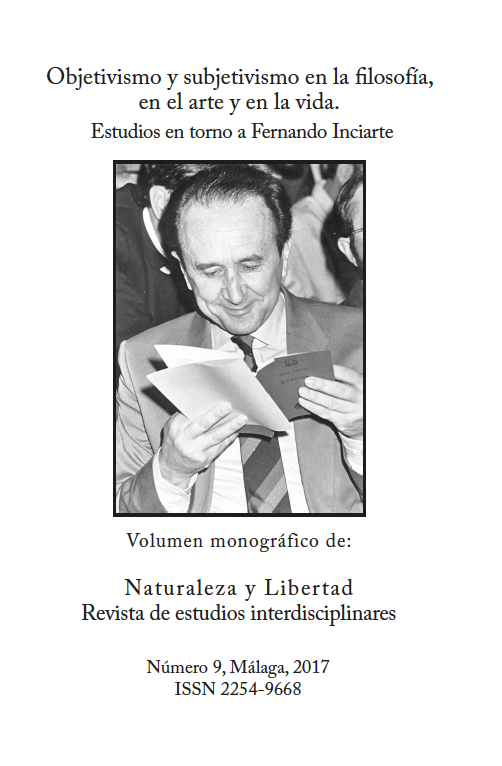Sensibilidades enfrentadas. Tarkovski o Malick, tiempo o montaje, icono o símbolo
DOI:
https://doi.org/10.24310/NATyLIB.2017.v0i9.6381Keywords:
Andréi Tarkovski, Terrence Malick, Fernando Inciarte, cine, icono, protestantismo.Abstract
En presente análisis estudia la posibilidad de vincular el cine de Andréi Tarkovski y Terrence Malick con dos sensibilidades específicas, esto es, con dos modos de concebir el arte en relación con la fe cristiana, siguiendo las reflexiones contenidas en el ensayo “Qué y cómo” de Fernando Inciarte. La hipótesis aquí desarrollada plantea, por un lado, la asociación de la obra de Tarkovski con una sensibilidad icónica y, por otro, la de la obra de Malick con una sensibilidad protestante. Este vínculo no se basa tanto en el contenido (plano conceptual), sino, sobre todo, en la forma artística (plano poético).Downloads
Metrics
References
P. Blanco y J. Ferrer, Lutero 500 años después. Breve historia y teología del protestantismo, Madrid, Rialp, 2016.
D. Davies, “Terrence Malick”, en: P. Livingston y C. Plantinga (eds.), The Routledge Companion to Philosophy and Film, Londres/Nueva York, Routledge, 2009, pp. 569-580.
N. Hay, “Cosmic Mourning: The Birth of Transcendence in Terrence Malick’s Tree of Life”, en: TRANS-. Revue de litte?rature ge?ne?rale et compare?e, 2014 (18).
C. Heber-Percy, “Reimagining Faith. Hope and the Kingdom of God in Tarkovsky’s Stalker: a modern spiritual journey into disaster, darkness, and redemption”. Texto de la comunicación presentada en la Film-Philosophy Conference 2016, University of Edinburgh.
F. Inciarte, “Qué y cómo o Sobre objetivismo y subjetivismo en el arte y su relación con diversas formas de vida”, en: Cultura y verdad. Sobre lo objetivo y lo subjetivo en el arte, la vida y
la filosofía (ed. L. Flamarique), Pamplona, EUNSA, 2016, pp. 27-161.
F. Inciarte, La imaginacio?n trascendental. En la vida, en el arte y en la filosofi?a (ed. M. A. Labrada), Pamplona, EUNSA, 2012.
F. Inciarte, Imágenes, palabras, signos. Sobre arte y filosofía (ed. L. Flamarique), Pamplona, EUNSA, 2004.
S. Kendall y T.D. Tucker, “Introduction”, en: Terrence Malick. Film and Philosophy, Londres/Nueva York, Continuum, 2011, pp. 1-12.
J. Kendrick, “An Improbable Career. The Films of Terrence Malick”, en Ch. B. Barnett y C. J. Elliston (eds.), Theology and the Films of Terrence Malick, Londres/Nueva York, Routledge, 2016, pp. 3-28.
P.J. Leithart, Shining Glory: Theological Reflections on Terrence Malick’s Tree of Life, Eugene (OR), Cascade Books, 2013.
P. Maher Jr. (ed.), One Big Soul. An oral history of Terrence Malick, Lulu.com, 2014.
J. Orellana y J. Martínez Lucena, Celuloide posmoderno. Narcisismo y autenticidad en el cine actual, Madrid, Encuentro, 2010.
J. Ratzinger, “La cuestión de las imágenes”, en: El espíritu de la liturgia. Una introducción (trad. Raquel Canas), Madrid, Ediciones Cristiandad, 2001, pp. 155-175.
S. Rybin, Terrence Malick and the Thought of Film, Lanham (MD), Rowman & Littlefield, 2012.
P. Schrader, El estilo trascendental del cine: Ozu, Bresson, Dreyer (trad. B. Viejo Viñas), Madrid, Ediciones JC Clementine, 1998
M. Tarkóvskaya, testimonio recogido en: VV.AA, Acerca de Andréi Tarkovski, Madrid, Jaguar Ediciones, 1988.
A. Tarkovski, Esculpir en el tiempo. Reflexiones sobre el arte, la estética y la poética del cine (trad. E. Banús y J.M. Gorostidi), Madrid, Rialp, 1991.
Downloads
Published
How to Cite
Issue
Section
License
Those authors who have publications with this journal, accept the following terms:
1. Copyright and licensing information are clearly described on the journal’s web site: all content published in Naturaleza y Libertad is open acces without limit, and are subject to the Attribution-NonCommercial-ShareAlike 4.0 International (CC BY-NC-SA 4.0) license. The full text of which can be consulted at https://creativecommons.org/licenses/by-nc-sa/4.0/
2. It is the responsibility of the authors to obtain the necessary permissions for the images that are subject to copyright. The authors whose contributions are accepted for publication in this journal will retain the non-exclusive right to use their contributions for academic, research and educational purposes, including self-archiving or deposit in open access repositories of any kind. The electronic edition of this magazine is edited by the Editorial de la University of Malaga (UmaEditorial), being necessary to cite the origin in any partial or total reproduction.
3. This journal allows and encourages authors to publish papers on their personal websites or in institutional repositories, both before and after their publication in this journal, as long as they provide bibliographic information that accredits, if applicable, your posting on it.
4. In no case will anonymous papers be published.





18.png)













